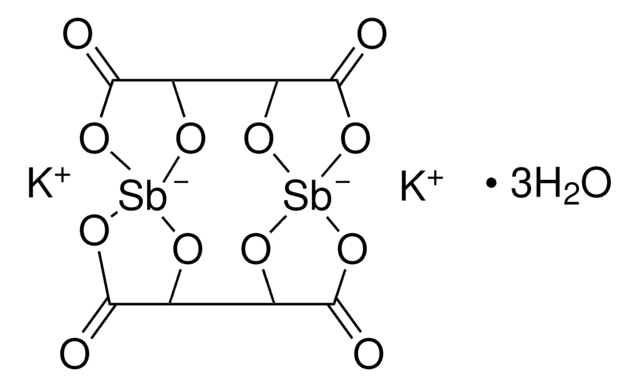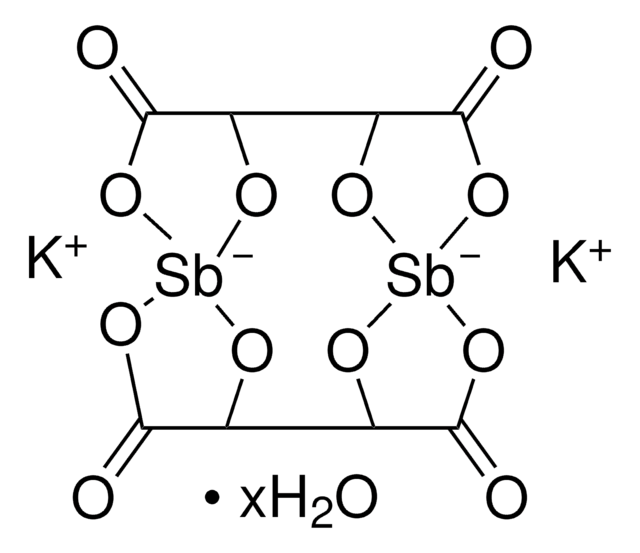推荐产品
等級
puriss.
品質等級
化驗
99.0-103.0%
形狀
powder
品質
meets analytical specification of USP
雜質
≤0.02 mmol/g free acid
≤0.02 mmol/g free alkali
損耗
≤2.7% loss on drying, 105 °C
mp
≥300 °C (lit.)
正離子痕跡
As: ≤150 mg/kg
Pb: ≤20 mg/kg
SMILES 字串
O.O.O.[K+].[K+].O=C1O[Sb-]23OC1C4O[Sb-]5(OC(C(O2)C(=O)O3)C(=O)O5)OC4=O
InChI
1S/2C4H4O6.2K.3H2O.2Sb/c2*5-1(3(7)8)2(6)4(9)10;;;;;;;/h2*1-2H,(H,7,8)(H,9,10);;;3*1H2;;/q2*-2;2*+1;;;;2*+3/p-4
InChI 密鑰
WBTCZEPSIIFINA-UHFFFAOYSA-J
正在寻找类似产品? 访问 产品对比指南
一般說明
Potassium antimonyl tartrate trihydrate is a trivalent antimonial compound. It has been reported to be more toxic than pentavalent antimony (Pentostam) against Leishmania species. Its crystal structure has been investigated by the three-dimensional X-ray and white radiation neutron diffraction techniques. It crystallizes in space group C2221. Unit cell dimensions reported were: a = 11.192(2), b = 11.696(3), and c = 25.932(5)Å.
應用
Potassium antimonyl tartrate trihydrate was employed as an Sb(III)-containing drug to investigate its ability to induce cell death associated with DNA fragmentation in axenic amastigotes of Leishmania infantum†
It may also be used as a standard solution to determine the metalloid concentration such as Sb(III) and Sb(V) in surface soil, using high performance liquid chromatography coupled to inductively coupled plasma-mass spectrometry (HPLC-ICP-MS).
It may also be used as a standard solution to determine the metalloid concentration such as Sb(III) and Sb(V) in surface soil, using high performance liquid chromatography coupled to inductively coupled plasma-mass spectrometry (HPLC-ICP-MS).
訊號詞
Danger
危險分類
Acute Tox. 3 Oral - Acute Tox. 4 Inhalation - Aquatic Chronic 2 - Skin Irrit. 2 - Skin Sens. 1
儲存類別代碼
6.1C - Combustible acute toxic Cat.3 / toxic compounds or compounds which causing chronic effects
水污染物質分類(WGK)
WGK 3
閃點(°F)
Not applicable
閃點(°C)
Not applicable
個人防護裝備
dust mask type N95 (US), Eyeshields, Faceshields, Gloves
其他客户在看
"A study of antimony complexed to soil-derived humic acids and inorganic antimony species along a Massachusetts highway"
Ceriotti G and Amarasiriwardena D
Microchemical Journal, Devoted to the Application of Microtechniques in All Branches of Science, 91(01), 85-93 (2009)
D Sereno et al.
Antimicrobial agents and chemotherapy, 45(7), 2064-2069 (2001-06-16)
The basic treatment of leishmaniasis consists in the administration of pentavalent antimonials. The mechanisms that contribute to pentavalent antimonial toxicity against the intracellular stage of the parasite (i.e., amastigote) are still unknown. In this study, the combined use of several
X-ray and white radiation neutron diffraction studies of optically active potassium antimony tartrate, K2Sb2(dC4H2O6)2? 3H2O (tarter emetic).
Gress ME and Jacobson RA.
Inorgorganica Chimica Acta, 8, 209-217 (1974)
D Sereno et al.
Antimicrobial agents and chemotherapy, 42(12), 3097-3102 (1998-12-03)
The mechanism(s) of activity of pentavalent antimony [Sb(V)] is poorly understood. In a recent study, we have shown that potassium antimonyl tartrate, a trivalent antimonial [Sb(III)], was substantially more potent than Sb(V) against both promastigotes and axenically grown amastigotes of
Susan Wyllie et al.
Biochemical pharmacology, 71(3), 257-267 (2005-12-02)
Trivalent antimonial compounds (Sb(III)), originally used in the treatment of leishmaniasis, are now being proposed as a novel therapy for acute promyelocytic leukaemia (APL). Here, we examine the effects of Sb(III) and pentavalent antimonial drugs (Sb(V)) on glutathione homeostasis, oxidative
我们的科学家团队拥有各种研究领域经验,包括生命科学、材料科学、化学合成、色谱、分析及许多其他领域.
联系技术服务部门













